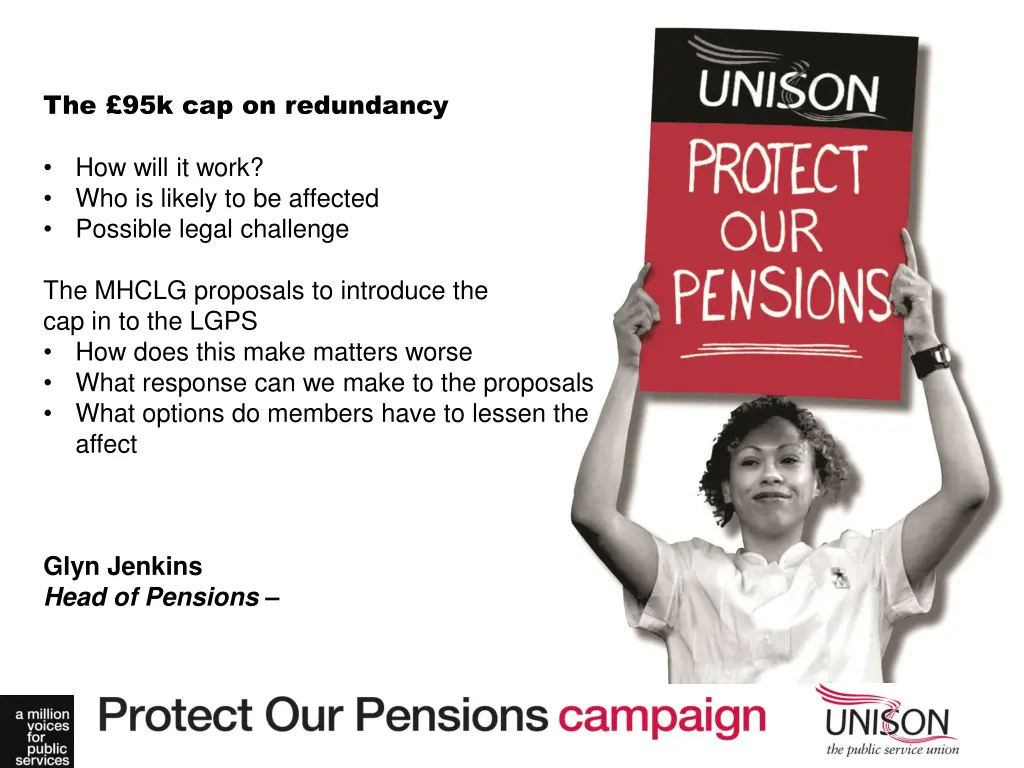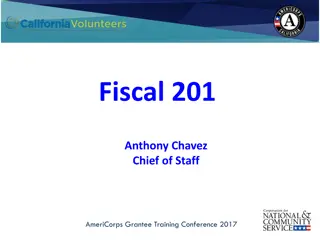
Understanding the Impact of the £95k Redundancy Cap on Local Government Pension Scheme (LGPS) Members
Learn about the implications of the £95k cap on redundancy payments for LGPS members, the legal challenges it may pose, responses to the proposals, and options for mitigating its impact on affected individuals. Discover how the new regulations affect severance packages and why LGPS employers are particularly affected.
Uploaded on | 2 Views
Download Presentation

Please find below an Image/Link to download the presentation.
The content on the website is provided AS IS for your information and personal use only. It may not be sold, licensed, or shared on other websites without obtaining consent from the author. If you encounter any issues during the download, it is possible that the publisher has removed the file from their server.
You are allowed to download the files provided on this website for personal or commercial use, subject to the condition that they are used lawfully. All files are the property of their respective owners.
The content on the website is provided AS IS for your information and personal use only. It may not be sold, licensed, or shared on other websites without obtaining consent from the author.
E N D
Presentation Transcript
The 95k cap on redundancy How will it work? Who is likely to be affected Possible legal challenge The MHCLG proposals to introduce the cap in to the LGPS How does this make matters worse What response can we make to the proposals What options do members have to lessen the affect Glyn Jenkins Head of Pensions
The government is pushed through its threat to limit severance payments to a total value of 95,000 in the public service. What does it mean for the LGPS? The Restriction of Public Sector Exit Payments Regulations 2020 How will it work? The Government laid a Statutory Instrument bringing in the exit regulations on 21 July on Wednesday 30 September it went back to the Commons Despite Opposition parties opposing it was passed. It became law and into effect from 4 November 2020 For those covered by these regulations who leave service on redundancy or efficiency of the service from 4 November the severance packages will not exceed a maximum of 95,000 in value.
Who will be covered, and can the restrictions be exceeded? Most LGPS employers in England and Wales are included. Example of employers that are not included are: Higher Education, Further Education and Private Contractors. Powers to relax restrictions are devolved to the Welsh Ministers for Welsh Authorities and to the Scottish Government and the Northern Ireland Executive to decide if and how it will apply in their Nations. England and Wales power to relax the restrictions is only by agreement of the whole council of a local authority however it is then only with HMT consent in England and a Welsh Minister in Wales.
Why LGPS is particularly hit Most of those effected by this cap in the LGPS will be those who are made redundant after it came into force. What do the Regulations allow now? Under current regulations a member made redundant or retired on the grounds of efficiency over the age of 55 has to take the pension they have earned in their current LGPS service immediately at the point of redundancy (including any previous LGPS service that a member has combined with the current service). This pension is not reduced by an early retirement factor for early payment as it would be if it was the member retiring voluntarily.
What does the employer pay? The LGPS employer then must pay their LGPS fund the cost of removing the early retirement reduction. The cost is based on the member drawing their pension from their normal pension age. If they draw their pension before they are receiving their pension for longer. Depending on how early this can be very expensive and put a strain on the LGPS fund if not paid for. That is why the employer is asked to pay the fund for this cost. This is called the strain cost.
So what happens with the 95,000 cap? This strain cost that the employer pays will be included in the 95,000 exit cap. The cap will also includes:- Statutory redundancy pay Any additional severance payment The statutory redundancy payment has to be paid so when this is added to the strain cost even some low and medium paid staff may hit the cap if they have more than 30 years service and made redundant in their mid to late 50 s.
So what happens if the 95,000 cap is breached? Until the LGPS regulations are amended they do not allow only part of a reduction to be removed. The Government believes The Restriction of Public Sector Exit Payments Regulations 2020 override the LGPS regulations. Regulation 8 says:- Where these Regulations prevent a relevant authority from making an exit payment of the type described in regulation 5(2)(b) which exceeds the exit payment cap in respect of a person, the relevant authority must, as an alternative, make to that person or in respect of that person to another person, a payment of an amount not exceeding the amount of that exit Payment
So what happens if the 95,000 cap is breached? In a letter to local authorities on 28th October 2020, Luke Hall MP the Minister for Regional Growth and Local Government wrote:- The Government s view is that LGPS members in that position should be able to elect to receive an immediate but fully reduced pension or, if they do not so elect, a deferred pension plus a lump sum equal to the capped strain cost. So it is likely the member made redundant and exceeding the cap will not receive an unreduced pension they are entitled to under the current LGPS regulations ( Regulation 30 (7) ) so they can appeal.
So what happens if the 95,000 cap is breached? UNISON is seeking test cases. We already have a couple of likely cases we can take forward. These are members who are over the age of 55 breach the cap and the fund believes they cannot pay the benefits as set out in the current LGPS Regulations. These cases could be subject to a Judicial Review and we are also with SAB seeking cases to fast forward to the Pensions Ombudsman for a quick decision.
So how do you know whether you are likely to breach the cap? It will depend on the following:- Your age when you are made redundant. If you are 55 the reduction and therefore the strain cost will be far higher than if you are say 61 How many years you have been contributing to the LGPS. Even on average to low pay if you have notched up 30 plus years you may breach the cap when Statutory Redundancy pay is added to the strain cost.
So how do you know whether you are likely to breach the cap if you accept redundancy? The simplest way is to ask your LGPS fund to see if they can supply the strain cost. So if you strain cost is say 85,000 and your SRP is 15,000 then your total of 100,000 exceeds the cap. All funds use one of 4 actuarial firms and how strain costs are calculated vary between funds. This will change when the LGPS Regulations are Amended and all funds will use standard factors supplied by the Government Actuary s Department
What if you do not breach the cap? Until the LGPS regulations are amended there is no change if the cost of the unreduced pension and SRP and discretionary severance payment adds up to less than 95,000. And the regulations are fully in force for employer not covered by the cap So lets now move onto the MHCLG proposals to introduce the cap into the LGPS England
Draft consultation MCLG on reforming exit pay. Not in force yet The consultation on the proposals ended on 9 November and UNISON submitted a central response and a template response was circulated to UNISON branches for members to make individual responses. The draft regulations only came in October so we lobbied for more time and the consultation on the draft regulations has been extended to 18 December It is up to the Welsh and Scottish governments and the Northern Ireland Executive to decide if or how this will apply in their Nations.
What are its main proposals For those over 55 being made redundant it proposes that the regulations allow for only part of the early retirement reductions be removed if the cap is exceeded. It proposes to give members the option to defer their pensions and take a severance payment instead of having a strain cost applied to increase the pension. If the member decides to take the pension and if the cap is exceeded, the member can pay any excess out of their own pocket or take the reduced pension.
Proposals also cover non LGPS areas and propose to replace the discretionary payments regulations The consultation proposes to limit discretionary severance payment for all members made redundant to :- A maximum of 3 weeks per year of service Up to a maximum of 15 months pay. Currently the employer has the discretion to pay up to 24 months Setting a maximum salary that an exit payment can be based (e.g. NHS scheme salary limit is 80,000)
The worst proposals to change for those over the age of 55 It also proposes that where a strain payment is made so the pension is unreduced for early payment, the member can only get the minimum statutory redundancy payment not any additional severance payment, even if the strain payment and additional severance payment would be under the 95,000 cap It also proposes to offset the Statutory Redundancy Pay against the strain payment so even if the cap is not exceeded the strain payment would be reduced so the pension would be less. This means even the low paid with short service will be hit
Example of how it would work: Worst proposals for those over the age of 55 The executive summary that was issued after the Consultation shows the likely impact on members and provides examples. The first based on the average salary for a member of 29,000 pa is made redundant at age 61 and has 19 years membership at date of leaving
Example of how it would work: Worst proposals for those over the age of 55 The executive summary that was issued after the Consultation began shows the likely impact on members and provides examples. The first based on the average salary for a member of 29,000 pa is made redundant at age 61 and has 19 years membership at date of leaving Statutory Redundancy Pay Discretionary Severence pay Pension strain Member receives 15,000 8,000 39,000 62,000
What member gets after the changes Row 1 is assuming the member pays SRP to the fund to retain full strain cost and unreduced pension. This roughly estimates to be around 9000 a year. Row 2 is if member decided to take the SRP instead of the full strain payment; Based on serious guesswork it would go down from 39,000 to 24,000. The reduced strain payment could remove around 61% of the full reduction for early payment, that guess based on the figures, is around 1,900. So 61% of 1900 is around 1150 so guesstimating the pension could go down from around 9000 to 8250 SRP DSP PS MEMBER RECEIVES - - 39,000 Full unreduced pension loses 23,000 SRP and DSP 15,000 - 24,000 Suffers pension reduction
So this is why the MHCLG proposals make things a lot worse for those who would otherwise not exceed the 95000 cap UNISON is in the process of getting examples checked that will be shared. There are worked examples in the draft GAD exit payments factors and guidance. However they are draft so could change. The GAD factors do not come into force until the regulations are changed. It looks like the GAD factors will come up with a lower strain payments than current fund based strain costs but UNISON assumes there will be some exceptions going the other way.
What responses can we make to the proposals? UNISON has already responded on 9 November and is responding to the draft regulations by 18 December. The response is not about the 95k cap but the proposed changes to the LGPS England. These are the major changes UNISON is seeking: Not to reduce the ceiling for discretionary severance payments. We do not support it because this will reduce the flexibility to set reasonable limits through collective bargaining. We completely oppose the proposal to offset Statutory Redundancy Pay and any discretionary payment against the cost of paying a pension not reduced by an early retirement factor.
What responses can we make to the proposals? UNISON is seeking another option where a member made redundant over age 55 decides they can defer the start of their pension. Instead of getting just Statutory Redundancy Pay and any discretionary payment if they defer the start of their pension, they should have the option for the deferred pension to be increased by the money the employer would have paid the fund to remove the early retirement reductions if the pension had been paid immediately. UNISON is concerned that members below the cap would have the option to take a potentially small severance payment instead of a possibly significantly more valuable removal of the early retirement reduction on their pension. We believe that this option should only be available where the 95k cap has been exceeded.
What responses can we make to the proposals? UNISON would seek to ensure whenever a cash alternative was offered the amount was no less than the capped strain cost. Consideration, as part of any final proposals, the promotion of strategies for introducing best practice policies for exploring alternatives to redundancy such as flexible retirement or re-deployment. It would show the strength of feeling in support of these changes if as many activist and branches as possible responded in support of these changes by the 18 December saying they would like the draft regulations to be changed. Model letters have been sent to branches.
What responses can we make to the proposals? If you want to download the draft regulations the link is https://www.gov.uk/government/consultations/reforming local-government-exit-pay The closing date for any comments on the draft regulations is 18 December 2020. Please send in any comments and responses to: LGExitpay@communities.gov.uk.
What options do members have to lesson the affect of the proposals and the 95k cap - Not agreeing to redundancy until they are shown the strain cap and whether the cap will be breached. - Consider alternatives to redundancy. Those over 55 can ask their employer to agree to flexible retirement. This is where the member cuts their hours or grade but remains in employment and can draw all or part of their pension.
In summary Action points Seek actual cases that we can consider taking to dispute. Respond to the MHCLG draft Regulations by 18 December Raise profile of the impact with members






















